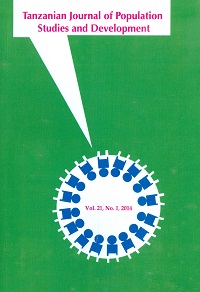Growth Determinants of Women-Owned Firms in Eritrea
Abstract
The paper discusses the growth of women-owned firms in Eritrea. Growth is defined by the increase in labour over time. The objective of the study is to identify the growth determinants of women-owned firms focusing mainly on selected covariates. It presents the theoretical review on the determinants of growth and provides country background. The paper is based on a study conducted on 370 women-owned small and medium enterprises (SMEs) in Eritrea. Two approaches were used. The first is χ2 where each explanatory variable is associated with growth. The second is the logit model on joint determinants of firm growth. The χ2 distribution identified three explanatory variables €”marital status, experience and prior training of owners €”as being associated with a firm ' s growth. Based on the logit model, we generated probability distribution of firms ' growth. It was observed that a typical female entrepreneur has 0.65 probability of success. The study concludes that women entrepreneurs who get training and prior experience opportunities before starting business as being successful.
References
Agresti, A. 1990. Categorical Data Analysis. New York: John Wiley & Sons.
Autere, J. & A. Autio. 2000. Is Entrepreneurship Learned? Influence of Mental Models on Growth Motivation, Strategy and Growth. Academy of Management Conference.
Baum, J.R., E.A. Locke & K.G. Smith. 2001. A Multidimensional Model of Venture Growth. Academy of Management Journal, 44(2): 292 €“303.
Begley, T.M. & D.P. Boyd. 1987. a Comparison of Entrepreneurs and Managers of Small Business Firms. Journal of Management, 13: 99 €“108.
Berry, W.D. 1993. Understanding Regression Assumptions. Sage University Paper Series on Quantitiative Applications in the Social Sciences, 07 €“092. Newbury Part, Ca: Sage.
Bottazzi, G. & A. Secchi. 2003. Common Properties and Sectoral Specificities in the Dynamics of Us Manufacturing Companies. Review of Industrial Organisation, 23: 217 €“232.
Delmar, K.M. & S. Shane. 2006. Does Experience Matter? the Effect of Foundign Team Experience on the Survival and Sales of Newly Founded Ventures. Strategic Organisation, 4(3): 215 €“247.
Eritrea. National Statistics Office and Fafo Ais (2013. Eritrea Population and Health Survey 2010. Asmara.
Ferreira, J.J., S.G. Azevedo & R.F. Oritiz. 2011. Contribution of Resource Based View and Entrepreneurial Orientation on Small Firm Growth. Cuadernos De Gestion, 11(1): 95 €“116.
Field, A. 2013. Discovering Statistics Using Spss, 3rd Ed. London: Sage Publications.
Fiseha Y. 1994. A Study of the Private Sector in Eritrea With Focus on Sme ' s. Mof and International Cooperation. Asmara.
Hagenaars J.A. 1990. Categorical Longitudinal Data: Log-Linear Panel, Trend and Cohort Analysis. California: Sage Newbuy Park.
Kuada, J. 2009) Gender, Social Networks and Entrepreneurship in Ghana. Journal of African Business, 10(1): 85 €“103
Macdade, B.E. & A. Spring. 2005. The 'New Generation of African Entrepreneurs': Networking To Change the Climate For Business and Private Sector-Led Development. Entrepreneurship and Regional Development: An International Journal, 17(1): 17 €“42.
Mateev, M. & Y. Anastasov. 2010. Determinants of Small and Medium Sized Fast Growing Enterprises in Central and Eastern Europe: a Panel Data Analysis. Financial Theory & Practice, 34(3): 269 €“295.
Mcdougall, P.P., R.B. Robinson, & A.S. Denisi. 1992. Modeling New Venture Performance: An Analysis of New Venture Strategy, Industry Structure and Venture Origin. Journal of Business Venturing, 7: 267 €“289.
Nandram & Samsom. 2000. Successful Entrepreneurship; More a Matter of Character Than Knowledge: Universiteit Nyenrode, Breukelen.
Rutashobya, L.K., I.S. Alan, & K. Nilsson. 2009. Gender, Social Networks and Entrepreneurial Outcomes in Tanzania. Journal of African Business, 10(1): 67 €“83.
Saunders, M., P. Lewis & A. Thornhill. 2012. Research Methods For Business Students. 6th Ed. England: Harlow Pearson Educational Limited.
Singh, S.P., S.M. Reynolds & S. Muhammad. 2001. A Gender-Based Performance Analysis of Micro and Small Enterprises in Java, Indonesia. Journal of Small Business Management, 39(2): 174 €“182.
Undp. 2014. Undp Human Development Report 2013. the Rise of the South. Human Progress in a Diverse World.
Welter, F. 2001. Who Wants To Grow? Growth Intentions and Growth Profiles of (Nascent) Entrepreneurs in Germany. Frontiers of Entrepreneurship Research: 91 €“147. Wellesley, Ma: Babson College
Witt, P. 2004. Entrepreneurs' Networks and the Success of Start-Ups. Entrepreneurship and Regional Development, 16(5): 391 €“412.
Yasuda, T. 2005. Firm Growth, Size, Age and Behaviour in Japanese Manufacturing. Small Business Economics, 24(1): 1 €“15.
Zhao, X., M. Frese & A. Giardini. 2010. Business Owners' Network Size and Business Growth in China: the Role of Comprehensive Social Competency. Entrepreneurship and Regional Development: An International Journal, 22(7 €“8): 675 €“705.
Zhou, H. & G. Wit. 2009. Determinants and Dimension of Firms Growth. Scientific Analysis of Entrepreneurship and Smes.


